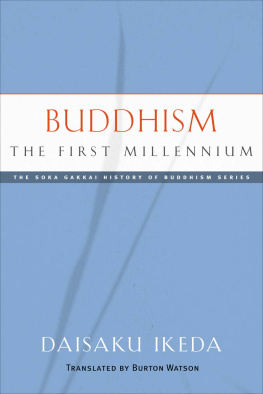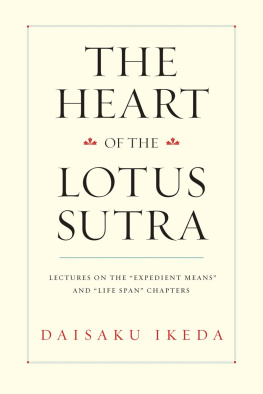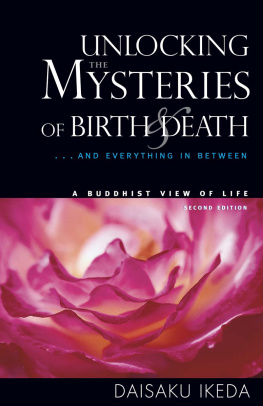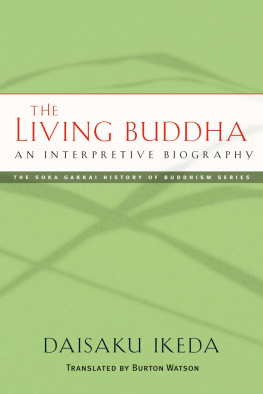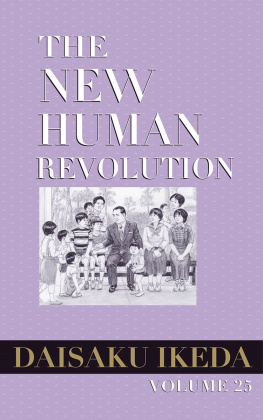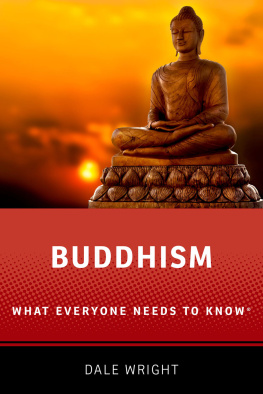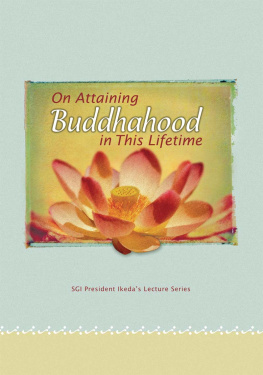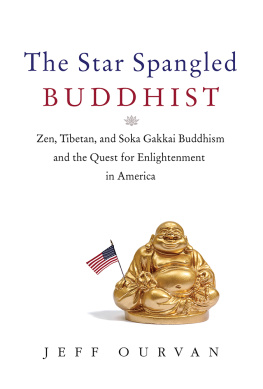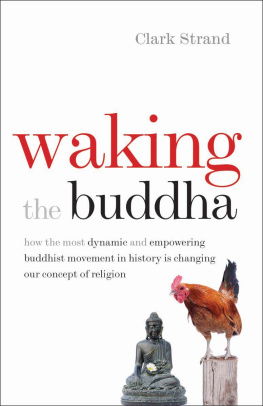Daisaku Ikeda - Buddhism: The First Millennium
Here you can read online Daisaku Ikeda - Buddhism: The First Millennium full text of the book (entire story) in english for free. Download pdf and epub, get meaning, cover and reviews about this ebook. year: 2012, publisher: Middleway Press, genre: Religion. Description of the work, (preface) as well as reviews are available. Best literature library LitArk.com created for fans of good reading and offers a wide selection of genres:
Romance novel
Science fiction
Adventure
Detective
Science
History
Home and family
Prose
Art
Politics
Computer
Non-fiction
Religion
Business
Children
Humor
Choose a favorite category and find really read worthwhile books. Enjoy immersion in the world of imagination, feel the emotions of the characters or learn something new for yourself, make an fascinating discovery.
- Book:Buddhism: The First Millennium
- Author:
- Publisher:Middleway Press
- Genre:
- Year:2012
- Rating:5 / 5
- Favourites:Add to favourites
- Your mark:
- 100
- 1
- 2
- 3
- 4
- 5
Buddhism: The First Millennium: summary, description and annotation
We offer to read an annotation, description, summary or preface (depends on what the author of the book "Buddhism: The First Millennium" wrote himself). If you haven't found the necessary information about the book — write in the comments, we will try to find it.
Beginning with the events immediately following the dark days after the death of Shakyamuni and continuing over a period of 1,000 years, this dynamic tome covers a vast and complex series of events and developments in the history of Buddhism. Through a thorough examination of its early development in India, a new light is cast on little-known aspects of Buddhist history and its relevance to the understanding of Buddhism today. Topics include the formation of the Buddhist canon, the cultural exchange between the East and West, and the spirit of the Lotus Sutra.
Buddhism: The First Millennium — read online for free the complete book (whole text) full work
Below is the text of the book, divided by pages. System saving the place of the last page read, allows you to conveniently read the book "Buddhism: The First Millennium" online for free, without having to search again every time where you left off. Put a bookmark, and you can go to the page where you finished reading at any time.
Font size:
Interval:
Bookmark:


Published by Middleway Press
A division of the SGI-USA
606 Wilshire Blvd., Santa Monica, CA 90401
1977, 1982 by Daisaku Ikeda
2009 Soka Gakkai
ISBN 978-0-9779245-3-0
All rights reserved
Printed in the United States of America
Cover and interior design by Gopa & Ted2, Inc.
This book originally appeared in Japanese under the title
Watakushi no Bukkyokan (My View of Buddhism),
published by Kodansha International Ltd., Tokyo, 1977.
Ikeda, Daisaku.
[Watakushi no Bukkyo-kan. English]
Buddhism, the first millennium / by Daisaku Ikeda ; translated by Burton Watson. 1st ed.
p. cm. (The Soka Gakkai history of Buddhism series ; 2)
Sequel to: The living Buddha. 2008.
Includes bibliographical references and index.
1. Buddhism. I. Watson, Burton, 1925- II. Ikeda, Daisaku. Watakushi no Shakuson kan. English. III. Title.
BQ4055.I3913 2009b
294.3dc22
2009017374
10 9 8 7 6 5 4 3 2 1
The following abbreviations appear in some citations:
- LS (chapter number), page number(s)refers to The Lotus Sutra, translated by Burton Watson (New York: Columbia University Press, 1993)
- WND-1 refers to The Writings of Nichiren Daishonin, volume 1 (Tokyo: Soka Gakkai, 1999)
In February 1961, I stood on the banks of the Ganges, the mighty river that begins as a tiny trickle of clear water among the Himalayas, the roof of the world, and races down from their towering peaks, traversing the foothills, to water the vast plain of the Hindustan. Near the city of Patna, where I was standing, it gathers into itself a number of large and small tributary streams. Close to this spot in ancient times stood Pataliputra, the City of Flowers, capital of the Maurya dynasty, the first kingdom to extend its rule over almost the entire Indian subcontinent.
The sacred Ganges flows on today, just as it did so long ago when Shakyamuni, having preached the most important series of sermons on the dharma, or Buddhist Law, to his disciples at Eagle Peak, crossed over it from the village of Patali, heading northward on foot in the direction of his old home of Kapilavastu. He was nearing the time of his death, a fact that he no doubt recognized. I wonder what he thought as he stood alone by the Ganges. Looking out over the vast surging waters, I tried to imagine what might have been in the heart of the Buddha.
For how many countless centuries has the river continued day after day to flow in this fashion? As long as the waters of life well up upon the earth, it will go on flowing. Like the Ganges, the profound and timeless wisdom of Shakyamuni, born in Lumbini Gardens in the foothills of the Himalayas, continued for more than a thousand years to flow through the land of the Indian people. From there, it spread south to Sri Lanka, southeast to the regions of Burma, Thailand, and Cambodia, northward through Central Asia and along the Silk Road into China, and by way of the Korean peninsula into Japan. In the time of King Ashoka in the third century BCE, Buddhist monks journeyed as envoys to the Greek states of the Macedonian empire, so that from early times it was already known to the West as well.
Shakyamuni, that extraordinary man of ancient times, died long ago, but he left behind a body of teachings the world had never known. These teachings were born of the passionate desire to save humanity. Handed down from one disciple to another, from one follower to ten thousand, they eventually became a vast current of faith transcending national boundaries.
Since that visit to India, the land where Buddhism was born, I have thought increasingly of the early history of Buddhism and have felt a desire to try to put down in writing some of my ideas concerning its founder. I realized a part of my desire by writing a book titled Watakushi no Shakusonkan (My View of the Buddha), which has been translated into English under the title The Living Buddha.
Needless to say, Buddhism is not the possession of Shakyamuni alone. Just as that vibrant life force, which Shakyamuni embodied and which inspired all of his teachings, has always existed and always will exist, so the Buddhist religion is a faith that continues flowing forward into the world, working ceaselessly for the salvation of all sentient beings everywhere.
After Shakyamunis death, his disciples gathered to put into formal shape the teachings he had left behind, eventually forming that huge mass of scriptures and commentaries that make up the Buddhist canon. Among these are the scriptures of Mahayana Buddhism, in particular the Lotus Sutra, which were formed at the hands of lay believers who strove to realize the bodhisattva ideal by working to spread Buddhism more widely throughout society. Each of these later disciples drew upon the life force of the eternal Buddha within them and pressed forward to the best of their ability toward the realm of enlightenment, the realm of the Buddha.
In my earlier book, The Living Buddha, I surveyed the life of Shakyamuni. In the present volume I would like to continue to trace the history of Buddhism, examining its early development in India and endeavoring to define the basic principles and ideals of the religion. As in the case of the earlier volume, I have drawn upon numerous excellent studies published by Buddhologists and Indologists, and I wish here to express my gratitude to them for their endeavors in the past and, as a Buddhist, to pray for the continued success of their research in the future.
In closing, I express my thanks to Burton Watson, formerly of Stanford and Columbia University and now one of the worlds most accomplished interpreters of Asian literary and religious texts, for the pains he has taken in preparing the translation.
The present volume is a translation of a work in Japanese titled Watakushi no Bukkyokan (My View of Buddhism). The original work was cast in the form of a discussion among Mr. Ikeda and two of his associates, but with his permission I have, for purposes of smoother reading, recast it in straight narrative form, taking care to preserve all the factual and speculative material of the original.
Sanskrit and Pali personal names, place names, and technical terms have been introduced in the text in the romanized form that seems most suitable for ordinary English readers, without the elaborate diacritical marks demanded by strict Indology.
As indicated by Mr. Ikeda in his preface to the English edition, the present work is a sequel to his earlier volume, The Living Buddha: An Interpretive Biography (reissued by Middleway Press, Santa Monica, California, in 2008), which deals with Shakyamuni, the founder of Buddhism. Treating as it does the life of a single individual, The Living Buddha is unified in subject and has a clear beginning, middle, and end. Moreover, Shakyamunis life, though marked at times by hardship and sadness, was on the whole a relatively untroubled one that ended on a triumphant note of accomplishment and optimism, and this sunniness is reflected in Mr. Ikedas treatment.
The present volume concerns itself with the story of Buddhism in the dark days after the death of Shakyamuni. It is perforce more diverse in content, covers a vastly greater span of time, and is in some ways more somber in tone, for, as so often happens in the history of religion, once the founder of the new faith had passed from the scene, doubt and dissension arose among his followers. Controversy developed concerning the correct interpretation of the doctrine, the correct practices and goals for the monks and laity, and the Buddhist Order in time was torn by schism. Mr. Ikeda, himself the leader of the Soka Gakkai International, a Nichiren Buddhist lay movement that has in recent years become the largest and most widespread in the world, describes these problems that beset early Buddhism, piecing out the scant historical facts with insight and conjecture. He succeeds in casting new light upon a period in the history of Buddhism that, because of the paucity of reliable data, is shrouded in uncertainty, bringing the account of its development down to the point where it began to spread beyond the borders of India and to grow into a major world religion.
Next pageFont size:
Interval:
Bookmark:
Similar books «Buddhism: The First Millennium»
Look at similar books to Buddhism: The First Millennium. We have selected literature similar in name and meaning in the hope of providing readers with more options to find new, interesting, not yet read works.
Discussion, reviews of the book Buddhism: The First Millennium and just readers' own opinions. Leave your comments, write what you think about the work, its meaning or the main characters. Specify what exactly you liked and what you didn't like, and why you think so.

